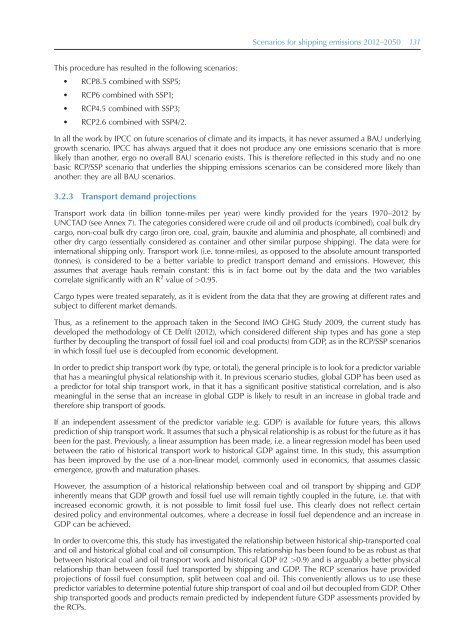MnrAq
MnrAq
MnrAq
Create successful ePaper yourself
Turn your PDF publications into a flip-book with our unique Google optimized e-Paper software.
Scenarios for shipping emissions 2012–2050 131<br />
This procedure has resulted in the following scenarios:<br />
• RCP8.5 combined with SSP5;<br />
• RCP6 combined with SSP1;<br />
• RCP4.5 combined with SSP3;<br />
• RCP2.6 combined with SSP4/2.<br />
In all the work by IPCC on future scenarios of climate and its impacts, it has never assumed a BAU underlying<br />
growth scenario. IPCC has always argued that it does not produce any one emissions scenario that is more<br />
likely than another, ergo no overall BAU scenario exists. This is therefore reflected in this study and no one<br />
basic RCP/SSP scenario that underlies the shipping emissions scenarios can be considered more likely than<br />
another: they are all BAU scenarios.<br />
3.2.3 Transport demand projections<br />
Transport work data (in billion tonne-miles per year) were kindly provided for the years 1970–2012 by<br />
UNCTAD (see Annex 7). The categories considered were crude oil and oil products (combined), coal bulk dry<br />
cargo, non-coal bulk dry cargo (iron ore, coal, grain, bauxite and aluminia and phosphate, all combined) and<br />
other dry cargo (essentially considered as container and other similar purpose shipping). The data were for<br />
international shipping only. Transport work (i.e. tonne-miles), as opposed to the absolute amount transported<br />
(tonnes), is considered to be a better variable to predict transport demand and emissions. However, this<br />
assumes that average hauls remain constant: this is in fact borne out by the data and the two variables<br />
correlate significantly with an R 2 value of >0.95.<br />
Cargo types were treated separately, as it is evident from the data that they are growing at different rates and<br />
subject to different market demands.<br />
Thus, as a refinement to the approach taken in the Second IMO GHG Study 2009, the current study has<br />
developed the methodology of CE Delft (2012), which considered different ship types and has gone a step<br />
further by decoupling the transport of fossil fuel (oil and coal products) from GDP, as in the RCP/SSP scenarios<br />
in which fossil fuel use is decoupled from economic development.<br />
In order to predict ship transport work (by type, or total), the general principle is to look for a predictor variable<br />
that has a meaningful physical relationship with it. In previous scenario studies, global GDP has been used as<br />
a predictor for total ship transport work, in that it has a significant positive statistical correlation, and is also<br />
meaningful in the sense that an increase in global GDP is likely to result in an increase in global trade and<br />
therefore ship transport of goods.<br />
If an independent assessment of the predictor variable (e.g. GDP) is available for future years, this allows<br />
prediction of ship transport work. It assumes that such a physical relationship is as robust for the future as it has<br />
been for the past. Previously, a linear assumption has been made, i.e. a linear regression model has been used<br />
between the ratio of historical transport work to historical GDP against time. In this study, this assumption<br />
has been improved by the use of a non-linear model, commonly used in economics, that assumes classic<br />
emergence, growth and maturation phases.<br />
However, the assumption of a historical relationship between coal and oil transport by shipping and GDP<br />
inherently means that GDP growth and fossil fuel use will remain tightly coupled in the future, i.e. that with<br />
increased economic growth, it is not possible to limit fossil fuel use. This clearly does not reflect certain<br />
desired policy and environmental outcomes, where a decrease in fossil fuel dependence and an increase in<br />
GDP can be achieved.<br />
In order to overcome this, this study has investigated the relationship between historical ship-transported coal<br />
and oil and historical global coal and oil consumption. This relationship has been found to be as robust as that<br />
between historical coal and oil transport work and historical GDP (r2 >0.9) and is arguably a better physical<br />
relationship than between fossil fuel transported by shipping and GDP. The RCP scenarios have provided<br />
projections of fossil fuel consumption, split between coal and oil. This conveniently allows us to use these<br />
predictor variables to determine potential future ship transport of coal and oil but decoupled from GDP. Other<br />
ship transported goods and products remain predicted by independent future GDP assessments provided by<br />
the RCPs.


